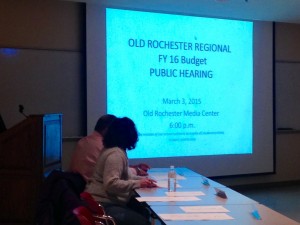It is not a level service budget per se, if you compare it to last fiscal year, but the FY16 ‘better school budget’ could be considered level service if one takes into account the growing student body at ORR.
With class size already a concern of the Old Rochester Regional School Committee, the projected increase in student population at the high school next year is expected to exceed 800 for the first time, further driving up class sizes and pushing some teachers beyond their contractual maximum student caseload.
“Seven-hundred has always been considered healthy,” said ORRHS Principal Mike Devoll on March 3. “Eight-hundred scares me.”
In the current 2014-2015 school year, according to Devoll, the average class size is 24.9; “extremely large,” as Devoll described it.
Since 2008, student population has increased steadily by 16.2%, while teaching staff has been reduced by 9.9%. The average caseload for teachers is 119, and the high school currently has 32 classes with 28 or more students enrolled.
“Ultimately,” said Devoll, “something has to give.”
The FY16 budget proposes adding two new English teachers for two additional sections of English to keep class sizes, currently at 23.6 students per class, steady at 22.4.
During the last joint meeting of the School Committees, committee members favored Devoll’s proposed addition of two new intervention skill-based math classes to help bridge the gap created by the transition from junior to high school, which has had a negative impact on MCAS scores.
“You can’t run those classes with class sizes the way they are now,” said Devoll.
Also proposed are one additional health class and a 0.4 teaching position for American Sign Language, which has been added to the foreign language curriculum as the school phases out French. Devoll said 41 students who otherwise would not fulfill the two-year foreign language college entry requirement have expressed interest in taking sign language.
In addition, two sections of physical education are included in the budget while specialist courses remain at level service.
The student population at the junior high is predicted to decrease slightly, as long as the committee votes to forego school choice slots a second year in a row. Last year, committee members voted not to offer any school choice slots out of concern for class sizes that climbed to an average of 28.
This budget proposes two new seventh-grade teaching positions and the addition of a new seventh-grade “mini-team” alongside the red and blue teams, to reduce class size to an average of 22.
Superintendent Doug White said lower class sizes in both schools would provide “more airtime” for students and a better chance for teachers to monitor and facilitate students’ progress.
“There’s a big difference between teaching 18 students and … 24, 25 students,” said White.
The only change in the specialist category is an increase in the library position from a 0.6 to a 1.0 position. White said the librarian could be available to more students as she takes on more of a media and technology teaching role.
A 35% increase in the demand for supplies funding also reflects the increased needs of a growing student body.
The cutting back of school choice, said White, has the potential to affect the budget over the next two years because of the loss of revenue to the tune of $120,000. The School Committee has not yet voted on whether or not to offer school choice slots to seventh grade for next year.
Total town assessment with this proposed budget of $17,269,113 – less transportation reimbursement and revenue – is at $13,993,254 and is broken down as follows: Marion – $4,230,738; Mattapoisett – $5,056,460; and Rochester – $4,706,056.
The Old Rochester Regional School Committee met again on March 11, after The Wanderer went to print, in order to vote on school choice.
By Jean Perry
